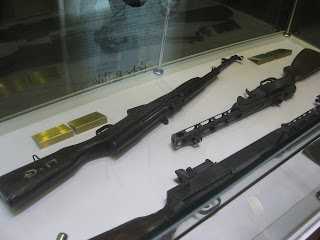After breakfast at the camp we got on the tour bus. Over the course of the trip we spent a lot of time traveling on the bus. Usually this time between locations was a good thing. It was a chance to rest a little, cool off, and reflect on what we had just seen.
Our tour guide for the DMZ visit was excellent. I am not very well read or knowledgeable about the conflict between North Korea and South Korea. Pete and I have watched several documentaries on North Korea and the oppression there. It is a very sad situation. Aside from my TV viewing, I knew little about the situation.
Our guide did an excellent job of explaining the progress of the war, the geographical features of the militarized zone and the demilitarized zone, the formation of the tunnels, the Sunshine Policy, and the political changes over the years. Although a cease fire was declared (and the nation was divided to provide a "buffer zone"), the Korean War never officially ended with a peace treaty. The nations are still considered to be at war with each other.
We stopped at one location and saw some monuments, the Peace Bell, and a wall of ribbons. The ribbons had names of family members and messages of hope & peace written on them. As I will learn throughout the trip, the idea of leaving written messages to loved ones and displaying them in public is a common practice throughout Korea. At many different points along the trip there was opportunities to do this. At this stop we walked through a small museum and saw a short video about the DMZ.
We got back on the bus and went to the Third Tunnel. The story of the tunnels is fascinating. It is estimated that the North Koreans may have started building upwards of 20 underground tunnels into South Korea. To date only 4 have been discovered. In the 1970's the South got information on the approximate location of several of these tunnels. In order to locate them they installed a series of water pipes into the ground in areas they suspected tunnels were being built. As the tunnels progressed, the water pipes drained into the newly built tunnels and were discovered. The Third Tunnel was discovered in 1978.
We hiked into the tunnel. Pictures were not allowed. It was a fairly steep incline deep into the earth. At the end we were approximately 170 meters from the North Korean border (kind of mind blowing!). The tunnel was short and we wore hard hats to protect our heads. At the end I drank from the DMZ spring. The walls were painted with charcoal, because at one point North Korea tried to justify the existence of the tunnels as coal mining tunnels.
We then traveled to another observation area along the DMZ. Here we could see across into North Korea. You can tell which area is North Korea, because there are no trees. North Koreans do not have energy sources for heating like the South does (natural resources, nuclear power plants). The only way to heat their homes is with fire wood, so all the trees have been harvested. You could only take pictures from behind a certain boundary line and the area was patrolled by the military.
Our last stop in the this area was Dorasan Station. This place was a mixture of both hope and sadness. It is a train station what was built to connect South Korea and North Korea. During the Sunshine period, there was great hope of reconciliation. These hopes have deteriorated as different political parties and leaders have come into power. It is an empty station right now, not functional, but remains as a symbol of what the future might hold.
Recently the media has been filled with bold, threatening statements that the North has made against the South and other democratic countries. I remember in 2010 there was an incident at sea in which it was suspected that North Koreans bombed a South Korean vessel. At the time we were waiting for Faith to come home. I was crazy with fear and worry. When I told many people about my trip, the first reaction they often had was concern regarding safety and the current political climate.
The concept of war and violence being so close to us is foreign to Americans. But to Koreans, most have lived in the midst of this conflict for most of their lives. As we traveled about I was frequently struck by the repeated messages of hope, unification, and peace. It seems to permeate their daily lives and is shaped by the constant reminders of the fact that they are a divided nation.








No comments:
Post a Comment